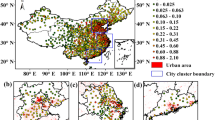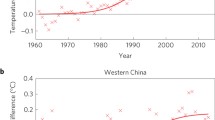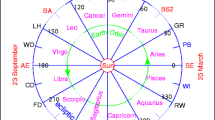Abstract
This study aims at qualifying the contribution of the urban effect to the total warming recorded by 45 urban or suburban stations in China where rapid and extensive urbanization over the last few decades occurred. Partly due to differences in urbanization and stations’ geographic location, the total warming trends for 1955–2012 vary from of −0.10 to 0.49 °C and −0.03 to 0.64 °C per decade for the annual averaged daily mean and daily minimum temperature, respectively. A principal component analysis of seven factors on the siting and geographical coordinates of the meteorological stations shows three dominant factors (urban size, relative position of meteorological station to city center and geographic location of station) accounting for 87.1 % of the total explained variance. An index quantifying the impact of the first two dominating factors of the urban effect is proposed considering also the dominating wind direction. The positive correlation between the temperature trends and the index is significant (P < 0.05), indicating that urbanization has significantly influenced the warming trends at these stations. The average contribution of the urbanization for all the stations to the total mean temperature trend is estimated to be 19 %.




Similar content being viewed by others
Abbreviations
- Au:
-
Urban area: Built-up land area, in km2
- Dir:
-
Direction: Direction of meteorological station relative to city center, 16 azimuth
- Dis:
-
Distance: the distance from meteorological station to city center, in km
- NDVI:
-
Normalized Difference Vegetation Index, unitless
- OLS:
-
Operational Linescan System
- PC:
-
Principal component
- PCA:
-
Principal Component Analysis
- Pop:
-
Population: non-agricultural population, in million
- R:
-
Radius: the radius of city shape simplified as circle, in km
- Rd:
-
Distance coefficient: the ratio of Dis and R, unitless
- Tmax :
-
Annual mean daily maximum temperature, in °C
- Tmean :
-
Annual mean daily temperature, in °C
- Tmin :
-
Annual mean daily minimum temperature, in °C
- UHI:
-
Urban Heat Island
- Uii:
-
Urban impact indicator: the degree of the urbanization impact on the recorded surface temperature, in %
- ESM:
-
Electronic Supplemental Material
References
Abdi H, Williams LJ (2010) Principal component analysis. Wiley Interdiscip Rev Comput Stat 2:433–459. doi:10.1002/wics.101
Chen D, Chen H (2013) Using the Köppen classification to quantify climate variation and change: an example for 1901–2010. Environ Dev 6:69–79. doi:10.1016/j.envdev.2013.03.007
Chen CTA, Drake ET (1986) Carbon dioxide increase in the atmosphere and oceans and possible effects on climate. Ann Rev Earth Planet Sci 14:201–235
Clarke JF (1969) Nocturnal urban boundary layer over Cincinnati. Ohio Mon Weather Rev 97:582–589. doi:10.1175/1520-0493
Ding Y, Wang S, Zheng J, Wang H, Yang X (2013) China climate. Science Press, Beijing
Fujibe F (2011) Urban warming in Japanese cities and its relation to climate change monitoring. Int J Climatol 31:162–173. doi:10.1002/joc.2142
Ge Q, Wang F, Luterbacher J (2013) Improved estimation of average warming trend of China from 1951–2010 based on satellite observed land-use data. Clim Chang 121:365–379. doi:10.1007/s10584-013-0867-4
Griffiths GM, Chambers LE, Haylock MR et al (2005) Change in mean temperature as a predictor of extreme temperature change in the Asia-pacific region. Int J Climatol 25:1301–1330. doi:10.1002/joc.1194
Hansen J, Ruedy R, Sato M, Imhoff M, Lawrence W, Easterling D, Peterson T, Karl T (2001) A closer look at United States and global surface temperature change. JGR: Atmos 106:23947–23963. doi:10.1029/2001JD000354
Heusinkveld BG, Steeneveld GJ, van Hove LWA, Jacobs CMJ, Holtslag AAM (2014) Spatial variability of the Rotterdam urban heat island as influenced by urban land use. J Geophys Res Atmos 119. doi:10.1002/2012JD019399
Hua L, Ma Z, Guo W (2008) The impact of urbanization on air temperature across China. Theor Appl Climatol 93:179–194. doi:10.1007/s00704-007-0339-8
Jones PD, Lister DH, Li Q (2008) Urbanization effects in large-scale temperature records, with an emphasis on China. JGR: Atmos 113. doi:10.1029/2008JD009916
Kalnay E, Cai M (2003) Impact of urbanization and land-use change on climate. Nature 423:528–531, http://www.nature.com/nature/journal/v423/n6939/abs/nature01675.html
Karl TR, Diaz HF, Kukla G (1988) Urbanization: Its detection and effect in the United States climate record. J Clim 11:1099–1123. doi:10.1175/1520-0442(1988)001<1099:UIDAEI>2.0.CO;2
Kim MK, Kim S (2011) Quantitative estimates of warming by urbanization in South Korea over the past 55 years (1954-2008). Atmos Environ 45:5778–5783. doi:10.1016/j.atmosenv.2011.07.028
Knight S, Smith C, Roberts M (2010) Mapping Manchester’s urban heat island. Weather 65:188–193. doi:10.1002/wea.542
Li Q, Zhang H, Liu X, Huang J (2004) Urban heat island effect on annual mean temperature during the last 50 years in China. Theor Appl Climatol 79:165–174. doi:10.1007/s00704-004-0065-4
Li Q, Li W, Si P, Gao X, Dong W, Jones P, Huang J, Gao L (2010) Assessment of surface air warming in northeast China, with emphasis on the impacts of urbanization. Theor Appl Climatol 99:469–478. doi:10.1007/s00704-009-0155-4
Liu B, Ming X, Henderson M, Qi Y, Li Y (2004) Taking China’s temperature: daily range, warming trends, and regional variations, 1955-2000. J Clim 17:4453–4462
Mohan M, Kikegawa Y, Gurjar BR, Bhati S, Kolli NR (2013) Assessment of urban heat island effect for different land use–land cover from micrometeorological measurements and remote sensing data for megacity Delhi. Theor Appl Climatol 112:647–658. doi:10.1007/s00704-012-0758-z
Owen TW (1998) Using DMSP-OLS light frequency data to categorize urban environments associated with US climate observing stations. Int J Remote Sens 19:3451–3456. doi:10.1080/014311698214127
Peterson TC (2003) Assessment of urban versus rural in situ surface temperatures in the contiguous United States: No difference found. J Clim 16:2941–2959, https://surfacestations.googlecode.com/files/Peterson2003.pdf
Ren Y, Ren G (2011) A remote-sensing method of selecting reference stations for evaluating urbanization effect on surface air temperature trends. J Clim 24:3179–3189
Ren G, Zhou Y, Chu Z, Zhou J, Zhang A, Guo J, Liu X (2008) Urbanization effects on observed surface Air temperature trends in North China. J Clim 18:1333–1348. doi:10.1175/2007JCLI1348.1
Stocker TF, Qin D, Plattner GK, Tignor M, Allen SK, Boschung J, Nauels A, Xia Y, Bex V, Midgley PM (2013) IPCC, 2013: Climate change 2013: The physical science basis. Working Group I Contribution to the Fifth Assessment Report of the Intergovernmental Panel on Climate Change
Stone B (2007) Urban and rural temperature trends in proximity to large US cities: 1951–2000. Int J Climatol 27:1801–1807. doi:10.1002/joc.1555
Tran H, Uchihama D, Ochi S, Yasuoka Y (2006) Assessment with satellite data of the urban heat island effects in Asian mega cities. Int J Appl Earth Obs Geoinf 8:34–48. doi:10.1016/j.jag.2005.05.003
Upmanis H, Chen D (1999) Influence of geographical factors and meteorological variables on nocturnal urban-park temperature differences-a case study of summer 1995 in Göteborg. Sweden Clim Res 13:125–139, http://pc70.gvc.gu.se/dc/PUBs/upmanischen99.pdf
Wang F, Ge Q (2012) Estimation of urbanization bias in observed surface temperature change in China from 1980 to 2009 using satellite land-use data. China Sci Bull 57:1708–1715. doi:10.1007/s11434-012-4999-0
Winkler JA, Skaggs RH, Baker DG (1981) Effect of temperature adjustments on the Minneapolis-St. Paul urban heat island. J Appl Meteorol 20:1295–1300. doi:10.1175/1520-0450
Yang X, Hou Y, Chen B (2011) Observed surface warming induced by urbanization in east China. J Geophys Res 116:D14113. doi:10.1029/2010JD015452
Zhang D, Shou Y, Dickerson RR (2009) Upstream urbanization exacerbates urban heat island effects. Geophys Res Lett 36:L24401. doi:10.1029/2009GL041082
Zhang N, Gao Z, Wang X, Chen Y (2010) Modeling the impact of urbanization on the local and regional climate in Yangtze River Delta, China. Theor Appl Climatol 102:331–342. doi:10.1007/s00704-010-0263-1
Zhao P, Jones P, Cao L, Yan Z, Zha S, Zhu Y, Yu Y, Tang G (2014) Trend of surface air temperature in Eastern China and associated large-scale climate variability over the last 100 years. J Clim 27:4693–4703. doi:10.1175/JCLI-D-13-00397.1
Zhou L, Dickinson R, Tian Y, Fang J, Li Q, Kaufmann RK, Tucker CJ, Myneni RB (2004) Evidence for a significant urbanization effect on climate in China. PNAS 101:9540–9544. doi:10.1073/pnas.0400357101
Acknowledgments
The research was supported by the National Natural Science Foundation of China [41171420], the Key Research Program of the Chinese Academy of Sciences [KZZD-EW-04] and the West Light Foundation of The Chinese Academy of Sciences [2013-165-04].
Author information
Authors and Affiliations
Corresponding author
Electronic supplementary material
Below is the link to the electronic supplementary material.
ESM 1
(DOCX 1407 kb)
Rights and permissions
About this article
Cite this article
Jin, K., Wang, F., Chen, D. et al. Assessment of urban effect on observed warming trends during 1955–2012 over China: a case of 45 cities. Climatic Change 132, 631–643 (2015). https://doi.org/10.1007/s10584-015-1446-7
Received:
Accepted:
Published:
Issue Date:
DOI: https://doi.org/10.1007/s10584-015-1446-7




